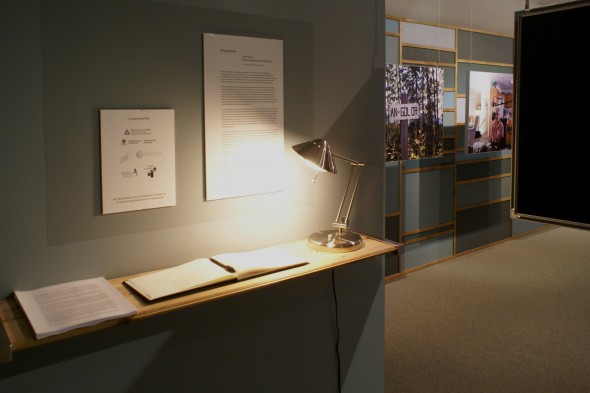John Wynne’s Anspayaxw at the ‘Ksan Museum gallery in Gitxsan territory, Hazelton, British Columbia

John Wynne's exhibition "Anspayaxw", 'Ksan Museum Gallery in Gitxsan territory. Photo courtesy John Wynne.
This past summer, artist John Wynne installed his exhibition Anspayaxw at the ‘Ksan Museum gallery in Gitxsan territory, in the town of Hazelton, British Columbia. Last year I wrote an essay about Wynne’s Anspayaxw for the Museum of Anthropology at UBC’s Border Zones exhibit called Asymmetrical Translations: The Art of John Wynne (you can read it here). I was really excited to hear that this essay was reproduced as introductory text for the ‘Ksan Museum exhibit and made available for distribution. Many thanks to John Wynne for sending me the image above, showing the placement of the essay in the gallery space.
This installation of photographs and sound was created on the Kispiox reserve close by. Anspayaxw, according to Wynne’s website,
…is a small reserve in northern British Columbia where I worked with linguist Tyler Peterson and visual artist Denise Hawrysio to record and photograph members of the Gitxsan community. Their native language, Gitxsanimaax, is one of many seriously endangered languages on the west coast of Canada, an area of remarkable but dwindling linguistic diversity. There are roughly 400 ‘competent’ speakers of Gitxsanimaax, but most of these are middle-aged or older and their average age is rising.
Several of the people featured in this installation managed to learn Gitxsanimaax as children despite attending residential schools where its use was forbidden. Such suppression of language by colonizing powers is far from rare: during the 18th and 19th centuries, children caught speaking their native tongue in Welsh schools were forced to wear a block of wood called the Welsh Not, which the wearer would pass on to the next pupil heard speaking the language until, at the end of the day or week, the unfortunate child in possession of it would be struck with it.
Language is a primary repository of culture and history, and once a language is no longer spoken, the rich knowledge it carries is gone forever. The linguistic diversity of the world is under threat: there are currently about 6,000 languages spoken now but it is variously estimated that between 50 and 90% of these will be gone by the end of this century.
The word Anspayaxw ends with a ‘voiceless fricative’, a breathy sound characteristic of the language which influenced the way I have worked with the environmental sounds. All the sounds in the piece are derived from the participants’ voices and recordings I made in and around Kispiox. Sometimes, these sounds are filtered, stretched and resonated, but no other sounds have been added.
The Border Zones website has a wonderful series of audio and video interviews with John Wynne, as well as installation photos.

